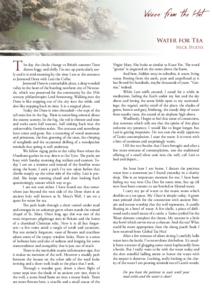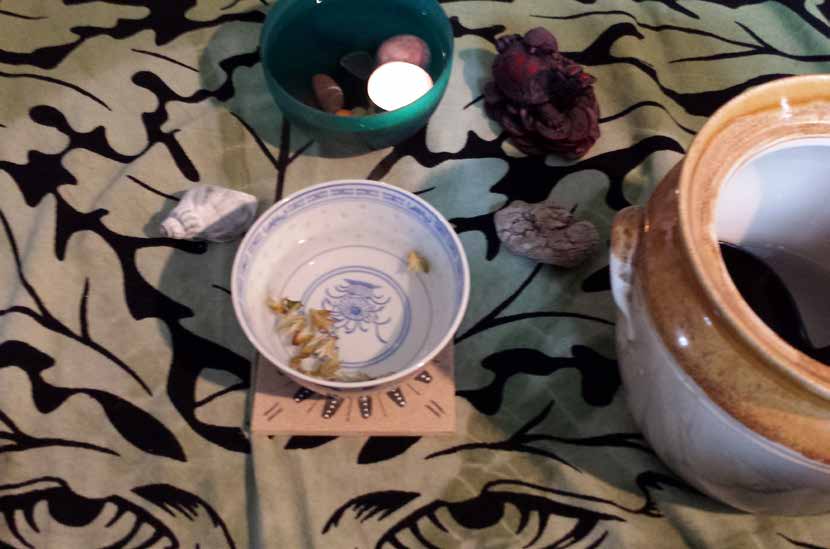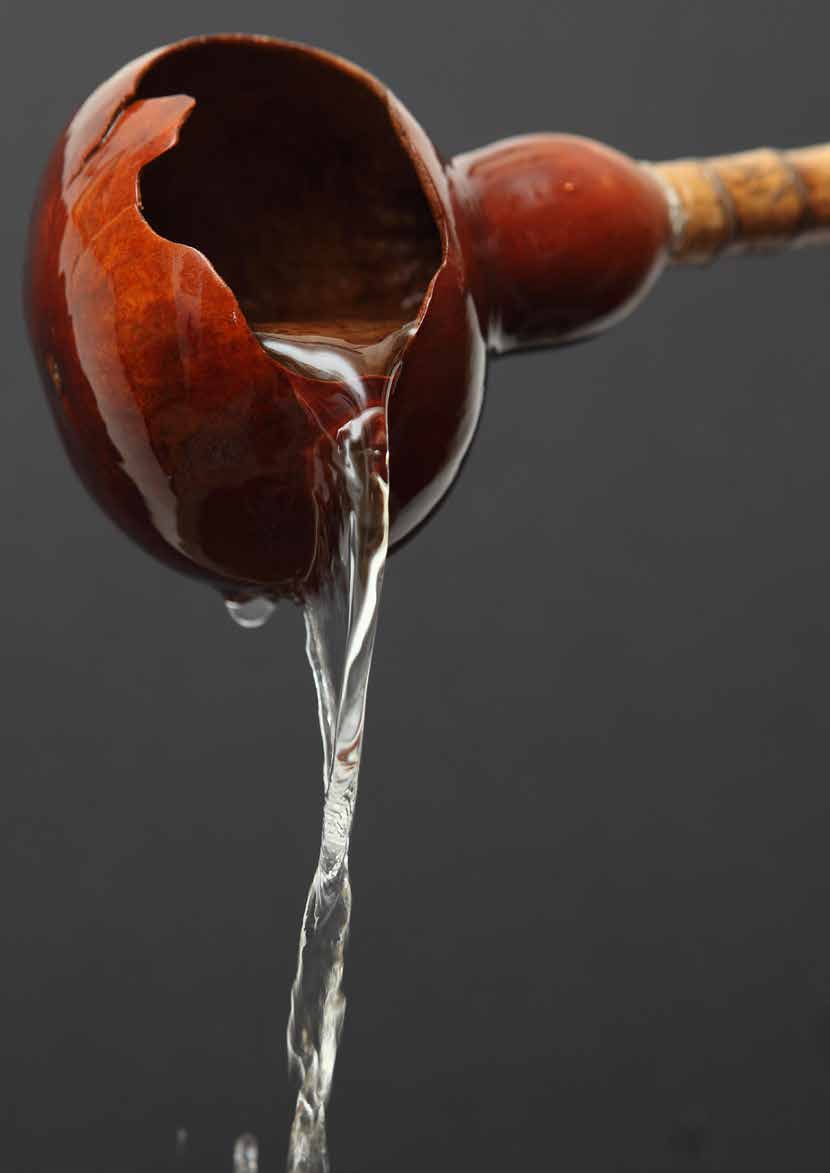
 |
|

The day the clocks change to British summer Time dawns foggy and chilly. I'm not up particulary early and it is mid-morning by the time I am at the entrance to Jesmond Dene with Lexi the Collie.
Jesmond Dene is a remarkable place, a deep wooded valley in the heart of the bustling northern city of Newcastle, which was preserved for the community by the 19th century philanthropist Lord Armstrong. Walking into the Dene is like stepping out of the city into the wilds, and also like stepping back in time. It is a magical place.
Today the Dene is mist shrouded - the tops of the tall trees lost in the fog. There is something oriental about the steamy scenery. In the fog, the veil is thinner and trees and rocks seem half nascent, half sinking back into the unknowable, formless realm. The crocuses and snowdrops have come and gone, but a scattering of wood anemones and primroses, the first greening of the trees, the chirping of songbirds and the occasional drilling of a woodpecker reminds that spring is well underway.
We follow zigzag paths to the valley floor where the Ouseburn gushes its way down to the Tyne. The paths are busy with Sunday morning dog walkers and runners. Today I am on a mission and instead of the familiar route along the burn; I seek a path I've not taken before that climbs steeply up the other side of the valley. Lexi is puzzled. She keeps running ahead and then looking back questioningly, unsure which way to go.
I am not sure either. I have found out that somewhere just beyond the west side of the Dene there is an ancient holy well known as St. Mary's Well. I am on a quest for water for tea.
The path leads through a short tunnel under road and emerges in an unkempt grove where stands the ruined chapel of St. Mary. Once long ago this was one of the most important pilgrimage sites in Britain and the home of a cherished Christian relic. Now it is all but forgotten - a few ruins amid a tangle of scrub and sycamore. But not entirely forgotten, vases of flowers and crucifixes adorn some of the empty window holes. There is a sense of holiness here and also of sadness and longing for some transcendence and tranquility that is just out of reach.
There is the inevitable tourist information sign, but it makes no mention of the well. However a muddy path between the houses on the other side of the road looks inviting and a short walk leads to the place that I seek.
Through a wooden gate, down a short flight of stone steps into the shade of an ancient yew tree, there is the well, a stone lined basin set into a mossy bank. There are more flowers here, a crucifix and a small statue of the Virgin Mary. She looks so similar to Kuan Yin. The word "gratias" is engraved on the stone above the basin.
And here, hidden away in suburbia, is water, living water, flowing from the earth, pure and unpolluted as it has flowed for hundreds, maybe thousands of years. "Gratias," indeed.
While Lexi sniffs around, I stand for a while in meditation, feeling the Earth under my feet and the sky above and letting the sense fields open to my surroundings: the vegetal, earthy smell of the place, the shades of green, brown and grey, birdsong, the steady drip of water from nearby trees, the sound of an airplane high above.
Wordlessly, I begin to feel that sense of connection, that nowness which tells me that the spirits of this place welcome my presence. I would like to linger longer, but Lexi is getting impatient. I'm not sure she really approves of Taoist contemplation. I taste the water. It is sweet with a hint of stoniness and surprisingly warm.
I fill the two bottles that I have brought and after a few more minutes of contemplation, toss the traditional offering of a small silver coin into the well, call Lexi to heel and depart...
An hour later I am home. I decant the precious water into a stoneware jar I found yesterday in a charity shop. This is an important moment for me. I have been feeling my way into Cha Dao for some time, but up till now have been content to use bottled or filtered water.
I carry my jar of water to the music room which doubles as a tea space. My Chaxi is simple today. A green man printed cloth for the connection with ancient Britain and nature worship that the well represents. A candle floating in a bowl of water. A few shells, a piece of driftwood and a small statue of a turtle, a Taoist symbol for the Water element complete the theme. My teaware is a little rice bowl which serves me as a chawan. And the tea? What could be more appropriate than the sheng puerh buds I have received from Global Tea Hut!

After a few minutes of silent sitting I carefully ladle water into the kettle. I've never done this before. It's usually been a matter of glugging some water haphazardly from a bottle. But I really want to be with the water today and the slow mindful ladling seems to honor the water with the respect it deserves. Looking, really looking at the clarity of the water I am pouring reminds me of Laozi's words:
Do you have the patience to wait until your mud settles and the water is clear?
I have got a smart temperature controlled kettle which I couldn't really afford, but a few months ago seemed essential. At the time, the idea of being able to judge water temperature by eye and sound seemed impossibly difficult. But today I leave the lid off the kettle, ignore the temperature dial and watch and listen as first steam begins to rise, then the first tiny bubbles, then strings of bigger bubbles....
Bowl tea is for me perhaps the ultimate expression of Cha Dao. The simplicity and the immediacy of leaves, water and a bowl takes me right into what Taoism calls "zi ran", the spontaneity, the naturalness of things as they are. I have no words to describe the rest of this tea session.
Why so much fuss about water? Am I crazy to have spent the best part of three hours collecting enough water for a couple of tea sessions? What is wrong with bottled water or filtered water? For me this is part of a process of growth as a chajin. For most of my life I drank tea as a beverage and was content to fill a kettle from the tap. Later, I passed through a short phase of tea connoisseur, or perhaps "tea snob" would have described me better. I filled my supermarket trolley with bottles of Volvic or Highland Spring water because only the best would do. However, very soon Tea became my teacher, and in silent sessions alone and intimate tea sharing with friends awakened me to her deeper meaning. Cha Dao became "practice" as much as sitting meditation, and it became a way of being in the spirituality of Nature. Bottled water was perhaps "gong fu" but it was not Cha Dao.
Cha Dao taught me that the essence of tea was not about indulging in elitist or exotic taste experiences. Cha Dao taught me too that the essence of tea was not just about drinking fine tea with meditative awareness. Cha Dao taught me that harmony, reverence, purity and tranquility are not confined within the walls of the tea hut, but like water, need to seep quietly into every part of one's being, purifying, nourishing and flowing gently but inexorably down to the vast ocean of Tao.
I can sit in my tea space and pour Volvic into my kettle. I can have an outer appearance of simplicity and tranquility and ignore the environmental impact of plastic bottles transported by fossil fuels across hundreds of miles, but how deep is such harmony and reverence? Cha Dao was asking me to see clearly and be responsible for my wasteful, consumerist actions and step back to a simpler and more honest connection with Nature. Cha Dao was asking for more effort and mindfulness on my part than casually turning on a tap and filling a filter jug.
In my tea journey, I had already embraced the idea of "living tea." Tea that was organic, grown lovingly by small farmers following ancient tradition and passed to me through bonds of friendship rather than business. My teaware had that living quality too, almost all of it coming to me in chance finds or as unexpected gifts. Now it was time to bring water to life, too.
There are hundreds, maybe thousands of wells and springs across Britain to be sought out as sources of water for tea. Some are officially sacred, some quietly ignored in the perfection of their ordinariness. Not long since, almost within living memory, they were our only source of water. If the well dried up or became tainted, there would be no water. Water mattered as it does today in so many parts of the developing world. Water, all water, not just water from "holy" wells, is sacred!
This does not mean that I will never again turn on a tap connected to the public mains supply to brew tea, but I hope that when I do there will be a little more awareness that water is just water... and is more than water.
The water I drew from St. Mary's well had once been ocean, had once been clouds, had once been rain. This water had been all these things since beginningless time and would be all these things again. The water that makes up most of my body has also been all these things and would be again. Through water I am one with Great Nature. Water is the common medium and material of life. As Laozi said, water is truly like the Tao itself:
The highest good is like water. Water gives life to the ten thousand things and does not strive. It flows in places men reject and so is like the Tao.
Just as I am finishing this article, I open We De's book, Tea Wisdom, at random and find these words by Buddhist scholar Dennis Hirota:
One does not prepare the water for one's own use, but rather participates in and enriches the water's existence as the water participates in and enriches one's own life. In this relationship, one experiences both a sense of wonder in the existence of the water just as it is, and a profound sadness that reverberates through the shared existence. .

Water is the "Mother of Tea". It supports and nourishes the essence of tea, as it also does so for all life. Nothing improves the quality of tea more than changing where you get water and how you store it. After years of hiking into the mountains to get spring water, we've noticed that besides the obvious ways in which the water has transformed our physical lives and spiritual journey through tea, the trips themselves have also had a huge impact our lives.
Try storing your water in an urn, and give it prayers of light and gratitude before drinking. You can experiment with crystals that have been put out in the sun, or full moon and see what effect they have on the water. Alternatively, make your morning Tea and then leave a glass jar of the same water out over night under the full moon. The next day brew the same Tea again. You will be amazed at the difference. And recognizing that the moon gets into our water, into us, is a part of awakening the harmony to Nature that is our healing.
People have always utilized prayer-filled water in healing, at churches or temples, in blessings and other holy rites. Water is the essence of life, even deeper and more elemental than plants. More than 90% of a bowl of Tea is water, so it is a huge force in the healing medicine of Tea and can't be ignored. As it makes up the vast majority of our bodies, an attention to it is a healing of us individually and globally. The sickness of the fresh water on this planet is testament to our sickness, and an omen from Mother Earth that we are in danger and need medicine.
